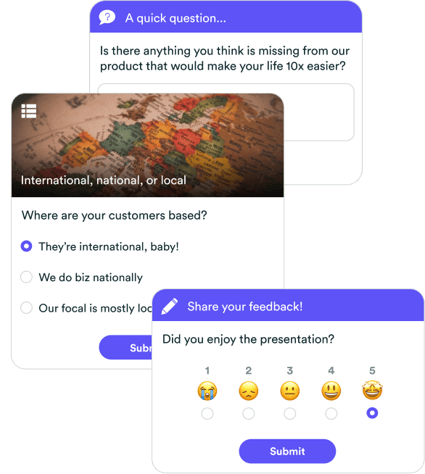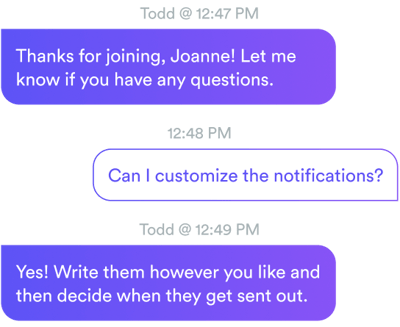How to Escape the Hell of Doing the Same Demo or Onboarding Webinar 1000X Over
If you’re a SaaS company and already use webinars or Zoom meetings to do your product demos or to onboard new customers, you know how effective they are. Prospects and customers love the high-touch, interactive experience, which means higher conversions and lower churn.
Webinars work, people love them.
There’s just one massive problem: someone always has to be there to run them live.
Which makes them completely unscalable.
Live webinars are usually offered infrequently and nearly always in the host’s time zone, making them super inconvenient to attend. It’s why webinar attendance rates are low (industry average is sub 40%), though impact is high for people who do attend.
People register just so they can watch the replay, but how many replays are sitting in inboxes today completely untouched? Webinars are so powerful and yet their reach when done live is inherently limited.
Five types of webinar hell
I’ve now worked with hundreds of companies struggling to scale their webinar strategy. Here are the 5 typical scenarios I see. Maybe you can relate to some of them.

1. Early stage founders who are doing all of their product demos and customer onboardings by themselves
They do it because they have direct relationships with customers and are obsessed with revenue. But they end up drowning in their demos, which means they don’t have the time or brain power to do much else. Founders are the best people to tell the story of why their product matters, but the opportunity cost of doing non-stop sales demos is huge.
2. Growing companies with small customer success teams who are tasked with onboarding and training hundreds to hundreds of thousands of users
These CS teams (sometimes of just 1 or 2 people) only host webinars a couple times a month at capacity because of all of their other responsibilities. Webinar duty is like a hot potato, nobody wants to commit to doing them on a regular basis. They end up finding makeshift solutions like putting videos on Youtube, but that means giving up the interactivity and chat that make their webinars effective. This is the most common scenario. What I’ve come to learn is that most companies, regardless of size, have relatively small customer success teams because they choose instead to invest their resources in sales.
3. Large established companies that have a whole team dedicated to running webinars around the clock
Companies like Freshworks and Salesforce do this, but with new users coming in every day, no matter how many they do, it’s still not enough and they wish they could do more.
With the size of their webinar audiences, it’s difficult to manage chat; a few people need to be put on a single webinar just to make sure questions are answered as they come in. Not to mention, it’s impossible to respond to unanswered questions when everyone gets booted out of the webinar room at the end. Live webinars are prone to tech glitches and connection issues too, and the larger the audience, the larger the impact when issues arise.
4. Companies scaling an enterprise product and doing tons of demos every day
Salespeople waste tons of time on unqualified leads or worse, on people who don’t even show up to their appointments. They want to figure out ways to make their sales process more efficient so time can be better spent on closing deals rather than doing demos for people who aren’t ready to buy.
5. Product-led companies with lower-ticket subscriptions where high-touch models don’t make financial sense
These companies can’t afford to do one-on-one demos and live onboarding, but their revenue depends on it so they do them anyway. Team members end up becoming frustrated from doing the same webinar over and over and having to deal with demanding, low-value customers all the time, which leads to burn out and high employee turnover.
These are five common examples of what I call “webinar hell”.
Regardless of company stage and size, running live webinars, especially repetitive ones, is time-consuming, mentally exhausting, and painful.
So painful, in fact, that many companies avoid doing them entirely, despite knowing how powerful webinars can be to drive adoption and engagement. They let their business suffer believing it's a compromise they have to make.
My own personal webinar hell
I personally lived in webinar hell for years while running my previous SaaS company, which was in real estate tech.

We always had a small team, so I was responsible for doing all our demos and onboarding.
Every new customer we closed wanted me to do a kick off webinar for them. But attendance was low (as it always is), so they would ask me to do another kick off, and another, and another.
Every one of those webinars was exactly the same. And no matter how many I did, it was never enough because there were always new users coming in. It wasn’t an effective use of my time but I couldn’t not do them because our revenue and customer happiness depended on adoption and engagement.
The more customers we got, the worse the problem got.
I tried putting videos into a knowledge base instead, but people didn’t like videos, they wanted webinars. They wanted somewhere they could interact and ask questions.
When it came to sales, I was doing demos for anyone who’d request one, including companies that weren’t ready to buy or that I knew wouldn’t make great customers, taking away time and energy I could have spent prospecting ideal customers. There’s nothing more discouraging than knowing in the first few minutes of a demo that the person is not going to buy but you have to do the full walkthrough anyway.
I looked for software that would let me present a pre-recorded video with the interactive qualities of a webinar, but everything I found was uninspiring, poorly designed, and not something I wanted to associate with our brand. Surprisingly, I found that most evergreen webinar solutions out there were built with the intention of deceiving consumers, to pretend a webinar was live when it wasn’t, which was not a practice I could get behind.
While I was experiencing all this, I was also traveling the world as a “digital nomad”, which added another layer of frustration. Not only was I doing these repetitive webinars live, I was doing them in the opposite time zones of my customers, which was hugely interfering with my life and keeping me from enjoying it.
Long story short, I was trapped in webinar hell and didn’t have the time or headspace to do much else. I knew there had to be a better way.
Fast forward to today, eWebinar frees people from the same trap I was in by turning a video into an interactive webinar that can be automated by setting it on a recurring schedule or making it available on demand.
Which means you can run as many webinars as you want without having to host them, and your customers can access the content anytime they want.
How eWebinar takes the pain away
When we were conceiving of eWebinar, we asked ourselves: What would it take to deliver a delightful experience attendees raved about that was fully automated for the host?
We distilled down all of the pain points we had experienced and came to realize we needed to achieve three main objectives with our software:
1. Maximum availability to increase attendance rates
What if I told you that you could only watch your favorite show on Tuesdays at 11am? That would never work; you expect to be able to go to Netflix and hit play whenever you want.
So why should consuming business content be any different? Why do we force prospects and customers to join our webinars at our convenience and not theirs? The way we deliver webinars in business today is completely out of touch with the way consumers watch and engage with video in their everyday lives.
And if you know webinars have a huge impact on the growth of your business, why would you let the growth of your business be limited by the schedule of your webinar host?

We designed eWebinar’s scheduling features to allow hosts to offer as many sessions as it would take to meet all of their customers’ needs. Attendees can join a session right away on demand, choose a later time that fits their calendar, or get a link to watch a webinar replay at their leisure. The result: giving attendees maximum flexibility to join sessions at their convenience led to a huge increase in attendance rates; the average attendance rate for eWebinar customers is 65% (63% higher than the industry average). And regardless of when or how they choose to watch, they still get the same high quality experience because it’s all built around a pre-recorded video.
"We see 80%-90% attendance rate with eWebinar, with multiple weeks of 100%. It's pretty extraordinary."
— Tom Foster, Director of Sales, The Receptionist
2. Interactivity throughout to keep attendees engaged and watching to the end
We’ve all been to webinars where we end up spending more time on Instagram than listening to the presenter. Oftentimes, you join a webinar only to have the host talk at you for an hour. There’s nothing to do, and nothing to contribute. We wanted to challenge the status quo and deliver an experience that’s less like a traditional webinar and more like interactive TV, where attendees can participate throughout by answering questions, getting access to more content via tips and downloads, and staying interested until the very end.

Because of the increased interactivity we made possible in our product, our customers saw big jumps in their audience engagement and average watch times after switching to eWebinar. One of our customers, who uses us for training and onboarding, reported a 169% increase in audience engagement. Another, who had switched from another automated webinar tool, reported watch times jumping from 70% to 90% using the exact same video!
“Literally everything across the board has gone up since we switched to eWebinar. We are having more people register. We're having more people attend. We're having more people stay longer in the webinars themselves. And they are interacting and engaging with the webinar more.”
— Kevin Andrews, Client Enablement Manager, BombBomb
3. Ability for attendees to ask questions and for hosts to respond in their own time, so they don’t have to constantly monitor chat
Being able to ask questions and interact with the host is the reason people make time to join a webinar. It’s how webinars are different from videos, which don’t have chat. With that communication channel missing, relationships can’t be built.
If chat is only available live, however, it requires the host to be there to respond while sessions are happening even if no questions get asked, which defeats the purpose of automation and being able to run webinars without being there.

We knew we needed to offer a robust chat system that would flexibly allow hosts to respond to attendees' questions in real time via live chat or asynchronously via email if they went offline. This type of chat system already exists and we encounter it every day. It’s like live chat support on a website when that little chat bubble pops up in the corner. If you ask a question and don’t get an immediate response, you know you’ll hear back later by email.
Providing this level of flexibility when responding to chat made it possible for our customers to make their webinars available 24/7 with peace of mind that every attendee question would still get answered, either in the moment or at the earliest convenience.
“The first time that I used eWebinar, I was blown away because I knew what the other platforms offered. And all of a sudden I’m connected to someone — a live person on the other end of this webinar product — and they’re answering my questions. I couldn’t believe it!”
— Matt Duhon, Fortune 500 Mortgage & Finance Services Company
These 3 core objectives became the backbone of what is now eWebinar.
Are you ready to escape webinar hell?
If you relate to the pain and problems described above, you now know there is a way out. Take it from someone who couldn’t escape webinar hell for years, the freedom on the other side is surprising and sweet.
Join our demo now or sign up for a free trial of eWebinar and see for yourself!









